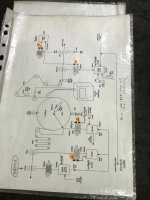janner_10
Lifetime Supporting Member
Attached is a sketch of our latest project, it's a retro fit of a Hudson Sharp bag machine.
It's basically a rotary knife (perforator) in this instance, that perforates webbing as it runs through the machine.
Line speed is roughly 100 m/m and bag length around 950mm
The Drum (Main) drive seals the plastic every xxx mm and the Perforator performs the cut someway down the line. The main drum also has a prox which gets made every time the seal bars touch the bag, the assumption is this creates a registration mark as it also is a DI to the Perforator Lenze Servo. The drum spins @ line speed (with dancer trim) and the length of the bag is determined by the diameter of the drum which is changeable.
The drum is currently on an AC Drive with the shaft encoder feeding directly to the B&R PLC. The perforation has to be @ the seal + / - an offset set from the HMI, this in effect makes the bag. A Lenze Servo controls the Perforator, the proceeding NIP rollers shaft encoder feed straight to the Lenze, which I'm guessing is speed feedback up stream.
It's an old B&R 2005 system so we have no access to the existing software. The perforator starts spinning along with all the drives on the line when it is started and takes around about 10 / 15 seconds for the perforations to get into the correct place in relation to the seal.
My problem is to CAM the knife to the proceeding nip rollers speed with the registration mark of the seal position, this I can do however, I would like to dynamically change the cut position or master lock position every cut, the bag length won't ever change mid-cycle but without this there is no checks or balances IMO, this is the part I am having trouble with.
Do I recalculate the cam every seal (registration) position and how do I move the new lock position value into that calc? and then into the MAPC.
New processor is a AB L82ES, with Kinetix 5700 drives. Any thoughts much appreciated.

It's basically a rotary knife (perforator) in this instance, that perforates webbing as it runs through the machine.
Line speed is roughly 100 m/m and bag length around 950mm
The Drum (Main) drive seals the plastic every xxx mm and the Perforator performs the cut someway down the line. The main drum also has a prox which gets made every time the seal bars touch the bag, the assumption is this creates a registration mark as it also is a DI to the Perforator Lenze Servo. The drum spins @ line speed (with dancer trim) and the length of the bag is determined by the diameter of the drum which is changeable.
The drum is currently on an AC Drive with the shaft encoder feeding directly to the B&R PLC. The perforation has to be @ the seal + / - an offset set from the HMI, this in effect makes the bag. A Lenze Servo controls the Perforator, the proceeding NIP rollers shaft encoder feed straight to the Lenze, which I'm guessing is speed feedback up stream.
It's an old B&R 2005 system so we have no access to the existing software. The perforator starts spinning along with all the drives on the line when it is started and takes around about 10 / 15 seconds for the perforations to get into the correct place in relation to the seal.
My problem is to CAM the knife to the proceeding nip rollers speed with the registration mark of the seal position, this I can do however, I would like to dynamically change the cut position or master lock position every cut, the bag length won't ever change mid-cycle but without this there is no checks or balances IMO, this is the part I am having trouble with.
Do I recalculate the cam every seal (registration) position and how do I move the new lock position value into that calc? and then into the MAPC.
New processor is a AB L82ES, with Kinetix 5700 drives. Any thoughts much appreciated.






